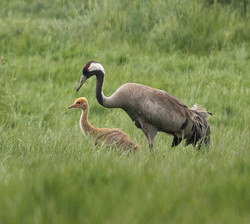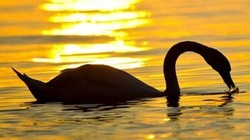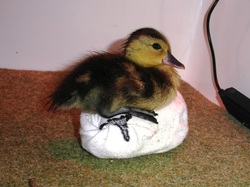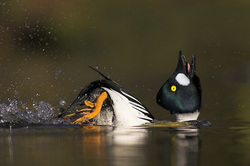
attached by scientists from Birds Russia on its breeding grounds this
summer.
Conservationists know that this bird 'Lime 01' fathered six fledglings this
summer — three that were hand-reared by conservationists and three that he
raised himself — which is 10 times the average for the species.
In all, this summer sixteen hand-reared Spoon-billed Sandpiper fledglings and
eight adults were marked with uniquely inscribed plastic leg flags. Birdwatchers
are being asked to report all sightings of Spoon-billed Sandpipers.
Coordinator of the Spoon-billed Sandpiper Task Force, Christoph Zöckler,
said: "The Rudong mudflats are an extremely important stop-over site for the
Spoon-billed Sandpiper to rest and feed and it is very exciting news that our
Russian breeding birds have been sighted there. Unfortunately these mudflats,
like much coastal wetland along the East Asian–Australasian Flyway, are
threatened by the development. Alongside illegal trapping and hunting, it has
pushed these birds to the edge."
WWT Head of Species Conservation Department, Baz Hughes, said: "This is why
we're taking extreme measures to prevent its extinction: hand-rearing chicks to
boost numbers, but Spoon-billed Sandpipers rely on the help of so many people.
Reports like this are only possible thanks to the support of birdwatchers
throughout Asia and are an invaluable part of its conservation."
Rudong mudflats are the most significant known staging post in China for
Spoon-billed Sandpipers, where 106 individuals were counted last year in
October. Demand for land is high in the region, which is only 150km from
Shanghai, and land has already been reclaimed from the marshes at Dongling to
the southern end.
Pavel Tomkovich of Birds Russia, who caught and marked the bird with Nikolai
Yakushev, said: "When I marked 'Lime 01' I wondered if anybody would ever see it
on its travels, almost a quarter of the way round the world, as looking for
Spoon-billed Sandpipers can be like looking for a needle in a haystack. Looking
for marked birds is even more difficult as we were only able to mark eight adult
birds with these unique flags. Thanks to the reports of local birdwatchers,
we're learning their stopover points."
'Lime 01' was seen leaving the breeding grounds on 4th August and was seen
5,000km away at Rudong on 31st August. Spoon-billed Sandpipers can cover as much
as 1,000km per day, leaving around three weeks during which it may have been
staging elsewhere
BTO Head of Projects, Nigel Clark, said: "We've known for a few years that
they stop at Rudong mudflats and we hope to be able to protect it. But our
calculations indicate that 'Lime 01' probably stopped somewhere else for up to
three weeks before reaching Rudong. We want to find out where that is in case it
is under threat."
Zhang Lin of the "Spoon-billed Sandpiper in China" Team said: "The first
Spoon-billed Sandpiper arrived at Rudong about two weeks ago since when I have
been regularly scanning the increasing numbers of waders at the high-tide roost
at Rudong. When I glimpsed a bird on 31st August that looked like it had a lime
green leg flag I knew something exciting was in front of me. On closer
inspection it turned out to be 'Lime 01'. I was over the moon as this is the
first time that one of the birds marked in 2013 has been seen in China. It is
amazing to see how these little but critically endangered birds are connecting
our key sites along the flyway between Russia and China. They are very important
as they allow us to track whether efforts to save the species are working."
Guidance on reporting Spoon-billed Sandpiper sightings is available from the
East-Asian Australasian Flyway Partnership Spoon-billed Sandpiper Task Force www.eaaflyway.net/spoon-billed-sandpiper.php. To
follow the progress of the Spoon-billed Sandpiper conservation breeding
programme visit www.saving-spoon-billed-sandpiper.com.







 RSS Feed
RSS Feed